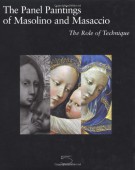The Panel Paintings of Masolino and Masaccio The Role of Technique
| Autore/i | Strehlke Carl B. and Cecilia Frosinini | ||
| Editore | Five Continents Editions | Luogo | Milano |
| Anno | 2002 | Pagine | 268 |
| Dimensioni | 24x30 (cm) | Illustrazioni | 140 ill. a colori, 120 ill. b/n n.t. - colors and b/w ills |
| Legatura | tela ed. sovracc. ill. colori - hardcover with dustjacket | Conservazione | Usato ottime condizioni |
| Lingua | Inglese - English text | Peso | 1600 (gr) |
| ISBN | 8874390009 | EAN-13 | 9788874390007 |
momentaneamente non disponibile
Contributi di Roberto Bellucci, Jill Dunkerton, Dillian Gordon, and Mark Tucker.
The combination of detailed technical studies with art historical insight sheds new light on the life, oeuvre, and working methods of two great Italian Renaissance masters Masolino and Masaccio.
A team from the Opificio delle Pietre Dure, the great conservation institute in Florence, joined by collegues from the National Gallery in London and the Philadelphia Museum of Art examined all their panel paintings in European and American museums with special single sheet X-radiographs and infrared reflectographic scanning equipment. Thanks to these methods, the researchers were able to enter into the painting technique of these artists in ways that even a few years before would not have been possible.
The study has lead to a greater understanding of the artists' collaboration and their chronology. It has also been possible to reconstruct more precisely a number of altarpieces and also question earlier reconstructions for Masaccio's Pisa altarpiece of 1426. Fine examples of Masaccio's underdrawing have been revealed as well as Masolino's innovative use of oil mediums. But the book is not only technical; all technical information has been correlated to art historical concerns about early Renaissance art such as the role of the guilds, the nature of collaboration between artists and other craftsmen, and the relationship between patron and artist. In fact, the book shows how a detailed technical study can answer or open up many questions that have previously been the purview of art historians who never knocked on the door of a laboratory.
The book contains technical entries for each of the paintings as well as photographs of their fronts and backs, X-radiographs, and infrared reflectograms. This introduction by Carl Brandon Strehlke summarizes the results and reviews the usefulness of laboratory research for this type of art history. An essay by Roberto Bellucci and Cecilia Frosinini interweaves a social and documentary history of the two artists' lives with a technical study of their paintings. Jill Dunkerton and Dillian Gordon's essay is on the vicissitudes of the Pisa altarpiece and problems of its reconstruction. Strehlke and Mark Tucker's essay on the Santa Maria Maggiore altarpiece discusses the two artists' last collaboration. There are also specific essays by Bellucci and Frosinini on the Carnesecchi and San Giovenale altarpieces. A glossary defines the many technical terms.
The book has been conceived for a general reading public and not necessarily only specialists on technique or historians of early Renaissance art.
Note alle condizioni del volume
Nessuna. (T-CA)
Potrebbero interessarti anche...





